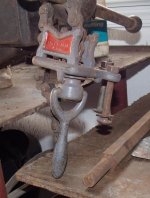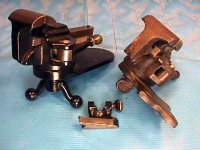epoclaen,
Your vise is the 'common or garden' variety of 'combination bench and pipe vise', as made by the Yost and Reed companies well into the mid-1930's, according to old catalogue listings.
The swivel system, using the notched cast base bolted to the bench, with the body of the vise held down by a large nut on a stud which passed down through the bench, was a continuation of an earlier pattern used on machinists' type vises in the 1880's, and maybe earlier. That design had the advantage of simplicity and cheapness, and, as Joe mentioned, would allow for the body of the vise to be mounted easily to an improvised or temporary job-site bench.
The original under-bench nut, for the Reed make (and your Yost vise is a copy of the Reed pattern, so the nut was probably the same as well), was a fairly heavy cast iron part, with the suitable tapped hole in the centre, and ends brought out into a 'ram's horn' configuration. It would have been approx 8" across the 'horns'. It was, for all practical purpose, a heavy wing-nut which could be tightened quite firmly with a moderately long bar through the 'horns'.
Any good blacksmith could make a 'period' looking forged nut, from, say, a short length of 1-1/4x4 flat mild steel, drawing out the ends to a gracefully tapered round, and curling them up nicely to resemble 'horns'.
Back in the 'real world', a suitable thick washer and heavy-hex pattern nut will put your vise in service quite adequately......... : )
cheers
Carla












